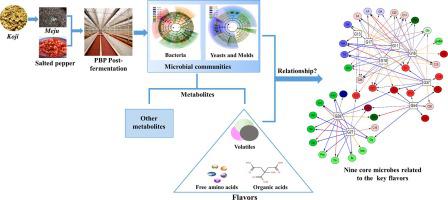Food Research International ( IF 8.1 ) Pub Date : 2020-07-08 , DOI: 10.1016/j.foodres.2020.109513 Ping Liu , Qin Xiang , Wenjia Sun , Xuemei Wang , Junfan Lin , Zhenming Che , Peihua Ma

|
Pixian broad bean paste (PBP) is a traditional Chinese condiment, famous for its distinctive flavor. Microbial communities play a vital role in producing the unique flavor of PBP, and a significant accumulation of these volatile flavors occurs during the post-fermentation stage of its production. However, little is known about the relationship between the microbes and flavor compounds in PBP. In this study, high-throughput sequencing (HTS) analysis revealed that Leuconostoc (8.30%), Lactobacillus (7.05%), Weissella (5.80%) and Staphylococcus (4.03%) were the dominant bacterial genera, while the most prevalent yeast genera were Zygosaccharomyces (41.45%) and Pichia (5.83%). Gradual accumulations of free amino acids (glutamic acid and asparagine), organic acids (malic acid and tartaric acid), and unique volatiles (aldehydes, phenols and pyrazines) were evident throughout the post-fermentation process. Analysis of the Pearson’s correlation coefficients between 66 key microbes and the key flavors was investigated. Nine core microbes were identified based on the linear discriminant analysis (LDA) scores ≥ 4 (or an average abundance >0.1%) and a high correlation with at least two flavor categories (P < 0.05, |ρ| > 0.8), namely Kosakonia, Kazachstania, Debaryomyces, Lactobacillus, Myroides, Stenotrophomonas, Ochrobactrum, Wohlfahrtiimonas, and Lactococcus genera. These results provide a clearer insight into microbial succession during PBP post-fermentation, thereby contributing to further quality improvement of PBP.



























 京公网安备 11010802027423号
京公网安备 11010802027423号